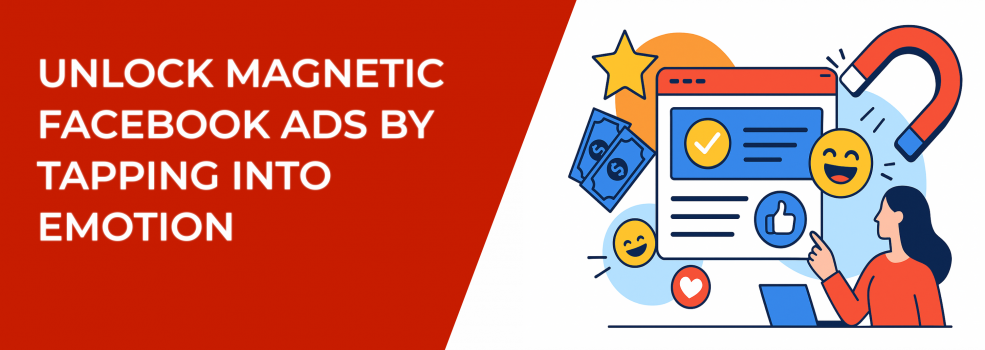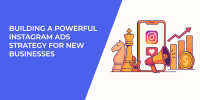Most Facebook ads go unnoticed.
They drift through newsfeeds, overshadowed by memes, messages, and moments people actually care about. So, what separates the forgettable from the scroll-stopping?
Emotion.
Emotional Facebook ads are more than marketing messages. They’re reflections of real life, capturing attention by speaking directly to what someone feels, wants, or needs. If your Facebook advertising strategy only leans on logic and features, you’re missing out on the power of emotional connection.
In this article, we’ll break down how to use emotional marketing to create more magnetic Facebook ads — ones that spark interest, drive clicks, and build brand loyalty.
Why Emotion Outperforms Logic in Facebook Ads
Facebook and Instagram are emotional platforms by design. People aren’t logging in to be sold to. They’re there to connect, explore, and escape — not to read another list of product specs or pricing offers.
That’s why emotional ads consistently outperform purely informational ones.
Think of a parent seeing an ad that says, “Finally get your evenings back.” It resonates more deeply than, “Our tool reduces your task time by 34%.” One speaks to a human need. The other sounds like a report.
Emotion influences how people remember your brand, how they talk about your product, and whether they take action. Emotional triggers like curiosity, relief, pride, and security turn passive scrollers into active buyers.
How to Create Emotionally Driven Facebook Ads
To build emotional Facebook ads that convert, you need to do more than pick nice images or catchy headlines. You need to uncover the emotional benefit behind your offer — the feeling your product or service promises to deliver.
Start by asking yourself:
-
What problem does this product solve emotionally?
-
How does someone feel before they use it?
-
What will change in their life once they have it?
Let’s say you sell fitness gear. You could talk about features — breathable fabric, ergonomic fit — or you could go deeper. Maybe your ad says, “Show up for yourself every day,” paired with an image of someone mid-workout, focused and confident.
This approach creates a story your audience wants to be part of. They’re not just buying a product. They’re buying how they want to feel — strong, capable, committed.
Tips for Writing Emotion-Driven Facebook Ad Copy
Writing emotionally resonant ad copy requires empathy, restraint, and a bit of storytelling skill.
Here are a few proven approaches:
-
Use conversational, personal language. Write as if you're talking to one person — not pitching a crowd. Skip the jargon and speak to real experiences.
-
Lead with emotion, follow with facts. Start your copy with a relatable feeling or scenario. Then explain how your product helps solve that emotional need.
-
Focus on transformation, not just features. Highlight how your offer changes someone's day, mindset, or confidence level. The emotional payoff is what sells.
-
Use emotional trigger words thoughtfully. Words like “relief,” “freedom,” “finally,” “stuck,” or “belonging” can quickly evoke recognition — when used sincerely.
-
Avoid hype and stay grounded. Trust is everything. Stay away from exaggerated promises and focus on real-world impact your audience can relate to.
These techniques work best when paired with a clear understanding of your audience’s mindset. Don't just write about the product — write from the perspective of someone whose life will improve because of it.
Want more in-depth help with phrasing, tone, and framing? This guide on crafting Facebook ad copy that converts is packed with formulas and real-world examples.
Tips for Creating Emotion-Driven Ad Creatives
Emotion lives in visuals. Before a user even reads your copy, their brain reacts to what they see. Your creative is your first emotional signal — make it count.
Here’s how to shape that signal effectively:
-
Show people, not products. Real people in real moments connect more deeply than static product shots. Focus on relatable, human-centered visuals.
-
Capture emotional states. Think beyond lifestyle photography. What does relief look like? What does personal victory feel like? Try to show that visually.
-
Use color and lighting with intention. Visual tone matters. For example, warm tones can signal comfort or nostalgia, while cooler tones might convey clarity or calm.
-
Keep your creative message simple. Complex visuals often distract. Aim for a clean composition that communicates a single feeling or idea instantly.
-
Test multiple emotional angles. Not every viewer responds to the same trigger. Testing variations — joy vs. relief, belonging vs. aspiration — can uncover what resonates most.
The emotional impact of an ad often happens in the first few seconds — sometimes even before a single word is read. That’s why your creative direction needs to be just as emotionally intentional as your copy. When they support each other, the ad becomes much more than just a marketing message. It becomes an experience that feels personal and relevant.
By grounding both your copy and your creative in emotion, you’ll create Facebook ads that feel more human, more memorable, and far more effective.
If you’re not sure how to visually translate emotion, this breakdown of how to stand out with stunning Facebook ad creatives will give you direction, even if you’re not a designer.
Choose the Right Creative Format for the Message
Different emotions call for different ad formats.
Some messages need space to unfold. Others thrive in short bursts. Facebook and Instagram offer a range of creative options that can enhance the emotional tone of your campaign — if you choose them intentionally.
For quick, bold emotions like surprise or excitement, short videos or Stories can work well. They deliver impact fast and feel native to the platform.
For deeper emotions like trust, nostalgia, or transformation, consider carousel ads or longer-form video. These formats give you room to build a narrative and showcase multiple angles of your product or service.
Your creative should visually reinforce the feeling you're aiming for. If your message is about calm or relief, your design and colors should reflect that. If you're promoting confidence and action, stronger visuals and dynamic imagery will support that tone.
Always ensure that your visual and emotional message align. Mismatched copy and creative can confuse viewers and weaken the emotional impact.
Targeting: Find the Feeling Behind the Behavior
Emotional marketing works best when it’s built on empathy. And Facebook’s targeting tools can help you find the right emotional context for your audience.
Rather than just targeting interests or demographics, dig into behaviors and life stages.
For example, if you offer stress-reducing supplements, targeting people interested in wellness is only one layer. You might also explore targeting recent graduates, new parents, or professionals in high-pressure industries. These groups aren’t just interested in wellness — they might be actively searching for relief, balance, or control.
Use Custom Audiences and Lookalikes to refine your reach, and test creatives that speak directly to their mindset.
Ask yourself:
-
What emotional state is this person likely in?
-
What outcome are they hoping for?
-
What would make them feel seen or understood in this moment?
By aligning your Facebook ad targeting with real emotional drivers, your messaging becomes much more relevant and more likely to lead to clicks.
For a more structured way to think about emotional segmentation, this step-by-step guide to defining a target audience for marketing will help you go beyond interests and build campaigns around mindset, behavior, and life stage.
The Real Power of Emotion-Based Facebook Advertising
When emotion drives your Facebook ad strategy, your campaigns do more than sell — they connect.
You’ll see stronger engagement, better click-through rates, lower cost per result. But beyond the numbers, you’ll build a brand that people actually care about.
In the noisy world of digital advertising, emotional relevance is what turns impressions into impact.
So, ask yourself: What does your audience really want to feel today?
Then build an ad that delivers that feeling.

